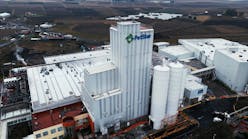Streamlining operations: Automation and digitalization in industrial wastewater treatment
When you think of wastewater treatment, you probably picture pipes, valves and manual labor. However, like many other aspects of today’s world, wastewater treatment has undergone significant automation. With the rise of digitalization and artificial intelligence (AI), wastewater management has entered the realm of advanced technology.
For industrial facilities, a changing compliance space is one of the drivers for more sophisticated methods to measure and treat their facility discharge and is propelling a digital shift throughout operations. Traditional wastewater treatment techniques, though effective under many conditions, often lack adaptability or a way to optimize efficiency based on changing wastewater parameters. Physical sampling and long or complex analytical methods create lag times between when a drop in efficiency happens and when an operator can respond to it. This lack of real-time data and actionable information results in subpar performance and increased operational expenses. Digitalization and automation are addressing these challenges while delivering additional benefits to industrial facilities.
The benefits of digitalization
Though digitalization often incurs additional costs, these expenses will quickly result in significant savings in the long run.
With advanced sensors, data analytics and automated controls, plant operators can gain unprecedented insights into their treatment processes in real time. These digital solutions provide industrial facilities with multi-level benefits in their wastewater. From monitoring pollutant levels to optimizing chemical dosing, every aspect of the treatment process can be fine-tuned for maximum efficiency and value, while still reducing operator time.
Cost savings
The precise control and optimization of treatment processes facilitated by digitalization lead to significant cost savings in wastewater treatment. By accurately monitoring chemical dosing, energy consumption, and equipment performance in real-time, plant operators can identify inefficiencies, optimize maintenance schedules, and reduce operating expenses.
Automation and predictive maintenance algorithms further contribute to cost savings by minimizing unplanned downtime and prolonging the lifespan of systems, helping reduce replacement costs over time. With a reduced need for full-time personnel to operate wastewater systems, the time can be allocated to other areas of your operations.
Efficiency improvements
Digitalization and efficiency go hand in hand. With automation and real-time monitoring and control capabilities, proactive (or automatic) adjustments to treatment parameters allow for optimal performance even under varying operating conditions.
Advanced analytics and logic algorithms can be applied with in-line sensors that measure flow, pH, total dissolved solids, etc. The collection of data with real-time analysis and automated actions enable continuous operational improvement to enhance process efficiency and resource utilization. Importantly, these data sets can also be used to identify trends in production discharge and potential areas for improvement relative to water conservation, chemical dosing or even potential equipment failures. As a result, wastewater treatment systems can not only achieve higher throughput and faster treatment cycles, but can also offer insight to improving overall production efficiency.
Regulatory compliance
In an increasingly stringent regulatory landscape, digitalization helps industrial facilities ensure discharge compliance to what they are permitted to send to a utility or to the environment. By providing accurate and reliable data on key pollutants regulated by your permits, digital monitoring systems enable plant operators to maintain regulatory levels and minimize the risk of non-compliance.
By tracking and retaining your own wastewater data, you can provide authorities with accurate reports directly from your system. Plus, automated reporting features that streamline regulatory reporting requirements help mitigate potential for resampling, accidental overages, potential violations and the associated penalties — all reducing risk to the facility.
Sustainability benefits
Most important, digitalization helps facilities grow and maintain sustainable practices. Digitalization and automation can minimize environmental impact and ensure efficient use of resources throughout the wastewater management process. By optimizing treatment efficiency and reducing resource consumption, plants can significantly decrease their carbon footprint and water usage, contributing to broader sustainability goals.
Advanced analytics identify opportunities for resource recovery and reuse, enabling plants to extract value from discharged production streams and minimize waste generation. Accurate data tracking also assists plants with carbon reporting, which is increasingly essential as we move towards stricter regulations for reporting across all three scopes.
Digital trends in wastewater treatment systems
When it comes to incorporating digitalization to wastewater treatment systems, you have two options. You can invest in a new onsite system that provides these advancements or you can upgrade an already existing system with digital tools to enhance your wastewater treatment. Either way, here are some current trends we are seeing that will continue to develop and become commonplace across the industry:
- Integration with IoT: The Internet of Things (IoT) is revolutionizing the way industrial systems communicate and interact. IoT sensors can provide extremely granular data on water treatment and enable seamless integration with other plant systems, facilitating data exchange and streamlining operations.
- Cloud-based solutions: Cloud computing enables real-time monitoring and automation of controls from anywhere in the world, empowering plant managers to make informed decisions on the go. Cloud-based solutions are an ideal platform for managing vast amounts of data generated by digitalized treatment and production systems.
- Advanced analytics: As data collection capabilities continue to expand, so too does the potential for advanced analytics. Predictive modeling, anomaly detection, and optimization algorithms will become increasingly sophisticated, driving continuous improvement and innovation in wastewater treatment processes, while minimizing resources.
- AI and machine ;earning: AI and machine learning are poised to revolutionize wastewater treatment by enabling autonomous decision-making and optimization. AI algorithms can analyze vast datasets to identify patterns and correlations that human operators may overlook. From predictive maintenance to adaptive process control, AI holds the potential to unlock new levels of performance and efficiency in industrial wastewater treatment.
Remote monitoring and control
One of the most significant benefits of digitalization is the ability to monitor and control wastewater treatment systems in real-time, remotely. Aquacycl provides this advantage so you can gain the most out of your wastewater treatment. Each individual reactor in an Aquacycl BETT treatment system relays real-time performance information that is also integrated with IoT flow meters, pH sensors and water quality meters, allowing us to monitor and control the system for optimal efficiency without the need for personnel onsite.
This real-time data not only allows us to react swiftly but also predicts potential issues before they escalate. By detecting deviations from optimal conditions early on, our team of wastewater experts are alerted and can promptly make any necessary adjustments, minimizing downtime and ensuring consistent treatment performance.
Luiza Moreno is a marketing specialist at Aquacycl.


